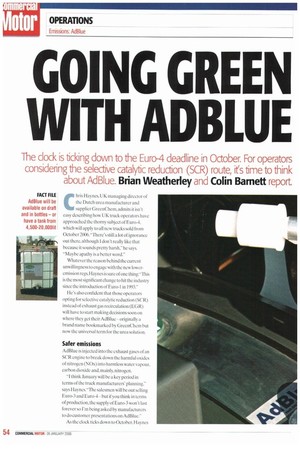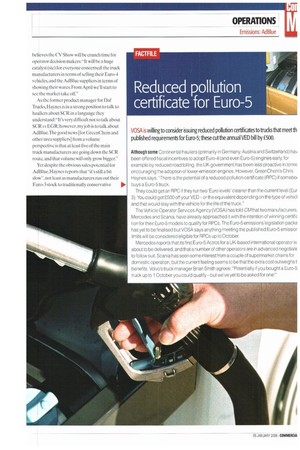GOING GREEN WITH ACIBLIJE
Page 54

Page 55

Page 56

If you've noticed an error in this article please click here to report it so we can fix it.
The clock is ticking down to the Euro-4 deadline in October. For operators
considering the selective cataly-ic reduction (SCR) route, it's time to think
about AdBlue. Brian Weatherley and Colin Barnett report.
Chris Haynes. UK managing director of the Dutch urea manufacturer and supplier GreenChem, admits it isn't easy describing how UK truck operators have approached the thorny subject of Euro-4, which will apply to all new trucks sold from October 2006.""Ibere's still a lot of ignorance out there, although I don't really like that because it sounds pretty harsh," he says. "Maybe apathy is a better word."
Whatever the reason behind the current unwillingness to engage with the new loweremission regs. Haynes is sure of one thing: "This is the most significant change to hit the industry since the introduction of Euro-1 in 1993."
He's also confident that those operators opting for selective catalytic reduction (SCR) instead of exhaust gas recirculation (EGR) will have to start making decisions soon on where they get their AdBlue — originally a brand name bookmarked by GreenChem but now the universal term for the urea solution.
Safer emissions
AdBlue is injected into the exhaust gases of an SCR engine to break down the harmful oxides of nitrogen (N0x) into harmless water vapour. carbon dioxide and, mainly.nitrogen.
"I think January will be a key period in terms of the truck manufacturers' planning." says Haynes. "The salesmen will be out selling Euro-3 and Euro-4— but if you think in terms of production, the supply of Euro-3 won't last forever so I'm being asked by manufacturers to do customer presentations onAdBlue."
As the clock ticks down to October, Haynes believes the CV Show will be crunch time for operator decision makers:"It will be a huge catalyst (sic) for everyone concerned: the truck manufacturers in terms of selling their Euro-4 vehicles,and the AdBlue suppliers in terms of showing their wares. From April we'll start to see the market take off."
As the former product manager for Daf Trucks, Haynes is in a strong position to talk to hauliers about SCR in a language they understand: 'It's very difficult not to talk about SCR vs EGR;however, my job is to talk about AdBlue.The good news [for CircenChem and other urea suppliers] from a volume perspective is that at least five of the main truck manufacturers are going down the SCR route, and that volume will only grow bigger."
Yet despite the obvious sales potential for AdBlue,Haynes reports that "it's still a bit slow", not least as manufacturers run out their F.uro-3 stock to traditionally conservative buyers. But time is running out."A lot of hauliers are already making enquiries about AdBlue because of budgetary reasons." says Haynes,"and come hell or high water you will be forced down the Euro-4 road."
For small fleets of up to eight vehicles GreenChem is offering a 1.(X1)-litre IBC which sits on a pallet.The IBC and pump normally remain the property of GreenChem (or one of its dealers); the operator pays for the AdBlue at a typical rate of 40p/lit.
Range of tanks For bigger fleet operators,GreenChem offers a variety of bulk tank options, from 4,500 litres to 20,000 litres. But operators aiming to avoid the high initial cost of buying a big storage tank will he able to lease or rent the infrastructure from GreenChem. with the cost of the bulk tank and pump equipment included in their AdBlue price per litre across an agreed contract period. VAT is levied on urea/ AdBlue, but Haynes says there's a European agreement not to impose duty on it.
Drivers will be able to top up their AdBlue tanks through all the major truck dealerships and truckstops using five. 10 or 18-litre cans,..as well as bulk installations through the likes of Key Fuels and through our own dealer network".Why 18 rather than 20 litres'?" Simple: Ad Blue weighs sonic 1.1kg per litre so 20 litres of urea, plus the weight of the can. would fall foul of the health and safety recommendations on manual handling.
As interest in AdBlue grows, Haynes says: "I'm enjoying knocking down the myths about urea.especially that it's corrosive. It isn't. It doesn't attack concretethat's one of the stories going about although it does interact with aluminium, which is why the manufacturers using SCR will supply their trucks with either stainless steel or plastic AdBlue tanks: In fact Haynes is more interested in keeping the aluminium away from his AdBlue, rather than the other way around."because if the alloy gets into the AdBlue solution it might affect the catalyst".
Overall, the message is that AdBlue should be treated with the same respect but no more than. say. diesel, in terms of avoiding excessive skin contact, inhalation or ingestion. And as Haynes says: "ii you were to launch a product as volatile as petrol onto the market today. there's no way they'd let you pump a liquid like that into an open tank.The health and safety people wouldn't allow it!
"Yet urea poses a significantly reduced threat compared with petrol."
































































































































































































